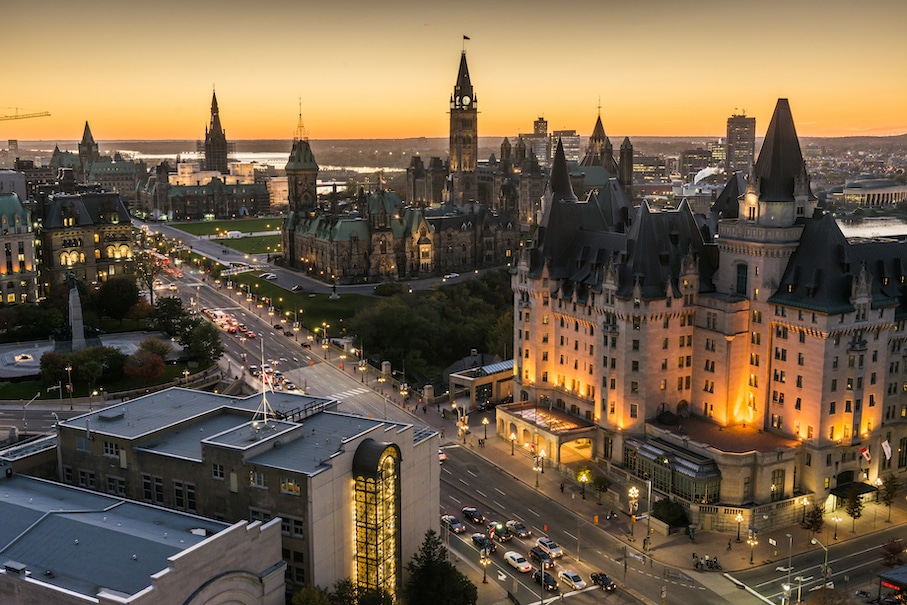
Panoramic view of downtown Ottawa showing Parliament Hill, the Fairmont Château Laurier and the Government Conference Center.
By Nancy Wigston
Who are Those Strange Canucks?
It’s been said that Canadians speak like Americans, spell like the British, and throw in an occasional French word to confuse people. Not quite true, that last bit, since Canada has two official languages, English and French. Fitting, then, that bilingualism rules in the nation’s capital, Ottawa, where both English and French share the stage, and a small apartment is likely to be called a pied-a-terre. But first, a little history.
Born on New Year’s Eve
Queen Victoria proclaimed Ottawa (formerly Bytown) the fledgling nation’s capital on New Year’s Eve 1855. Its name, an anglicization of the Algonquin word for “trade,” is apt since the city is located at the confluence of the Ottawa, Rideau, and Gatineau rivers, long used as indigenous trade routes. Canadians believe the capital’s location represents a compromise between French and English-speaking Canada since it is safely distanced from America, which tried to annex a southern slice of Ontario during the War of 1812. At the time, historian Goldwin Smith sniffily dubbed Ottawa a “sub-Arctic lumber village converted by royal mandate into a political cockpit.” So much for compliments.
The Many-Sided Northern Capital
Although Canadians love little more than arguing about their identity, they mostly agree about their four biggest cities. Montreal is “ben fun,” French/English slang for a good time. Toronto is the nation’s business center while Vancouver is a wonder of natural beauty. And Ottawa? Well, it might be the best place to discover the Canadian soul.
Says Ottawa Tourism head Jantine Van Kregten, “Americans wonder how Canadians are similar and how they are different. Ottawa provides the answers, with national museums that tell the stories of Canada and its diverse peoples.
“But it’s especially at festivals and in bars and restaurants that you’ll discover what makes Canadians tick. Cultural explorations are easily accessible: from a singalong pint at the Heart and Crown pub to impressive international performances at the Ottawa Bluesfest; from dance or theatre at the National Arts Centre to bluegrass nights at Red Bird Live or country musician Lucky Ron at the atmospheric Château Lafayette.”
As for soul, Canadians have long recognized their world, or a colorful version of it, in The Group of Seven, artist friends who came together in 1920 and headed out to the woods to paint. Inspired by the north, The Group of Seven are familiar, even iconic–not just because their work is popularly reproduced, particularly in banks, on coffee cups and calendars–but because they captured an idealized essence of what seemed a largely empty land, mysterious, lush, and powerful. And popular. Avid Group of Seven collectors include comedian Steve Martin–incidentally famous for his “wild and crazy guy” SNL skit with Ottawa native Dan Ackroyd. Martin particularly loves the moody modernist Arctic paintings by Group of Seven founder Lawren Harris. If you’re looking for Canadian soul, the National Gallery is a good place to start.
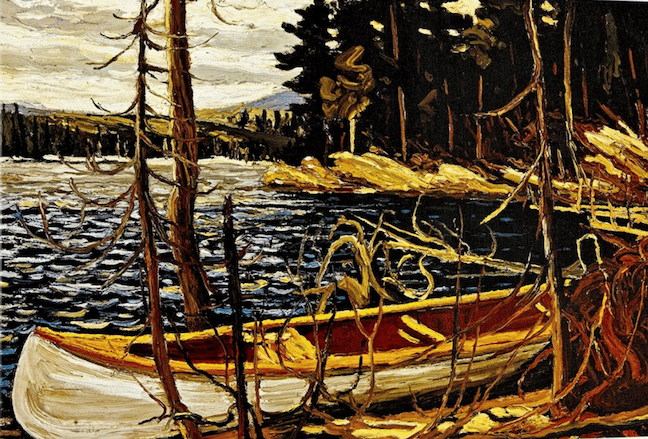
“The Canoe” by Tom Thomson, one of the Group of Seven artists whose artistry captured the tranquility and texture of rural Canada.
Strolling for Fun, Skating to Work
Art expert Charles Hill, curator of Canadian art for decades at the National Gallery, describes Ottawa as the ideal city. “Well treed, with numerous parks and magnificent heritage buildings overlooking the Ottawa River, Ottawa is a city to be experienced on foot.”
The National Gallery of Canada, the Canadian Museum of History and Canadian War Museum are situated along the banks of the river linked by an early twentieth-century pedestrian bridge. The Canadian Museum of Nature and Canadian Museum of Science and Technology are not far away. Neighborhood farmers’ markets are situated around the city and good restaurants can always be found nearby. North of Ottawa’s twin city, Gatineau, is Gatineau Park, a favored spot for hiking in the summer and for cross-country and downhill skiing in the winter. When the weather allows, the Rideau Canal becomes a skating rink down the center of the city.
Writer and retired journalism professor Peter Johansen, an Ottawa resident since 1965, echoes this take on the city he loves, with discoveries like the “new hidden gem,” Tavern at the Gallery. Tucked away in a National Gallery courtyard, the tavern makes a relaxing start for exploring the gallery’s collections as well as its reconstructed 19th century Convent Chapel.
There is a lot of northern history packed into this city of a million or so, all easily accessible by walking, biking, or skating on the frozen Rideau Canal, a UNESCO Heritage Site Johansen calls “the world’s largest skating rink.”
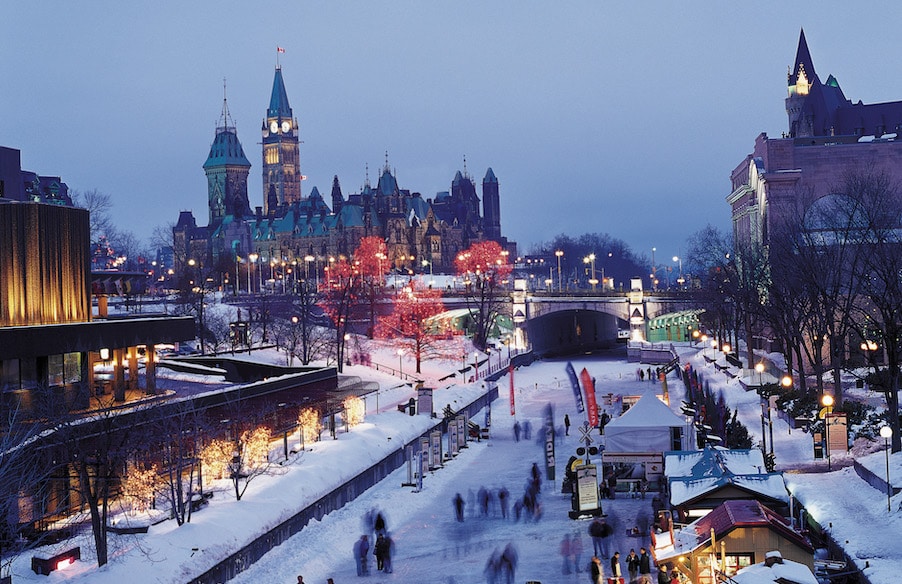
During long winter nights, residents of Ottawa gather on the frozen Rideau Canal for music, mulled wine and skating.
How cold, you might wonder, does it get for the canal to freeze and become a skater’s thoroughfare? For three or even four months, (early December-mid-March) Ottawa temperatures hover between 5 F and 32 F. Plus there’s lots of snow.
Locals out for a stroll tend to follow the Rideau Canal. “For natural beauty, the path bordering the Ottawa River meanders past the rear of the Parliament Buildings, Supreme Court, and the War Museum of Canada. The forested wetlands of Britannia Conservation Area bring wilderness into the urban core,” says Johansen.
Another Ottawa insider, Laura Byrne Paquet, who authors a series on Ottawa Road Trips, likes to point out Ottawa quirks like the intersecting streets Scully Way and Mulder Avenue, which serve as a tribute to the X-Files TV series.
For the freshest take on the city, Laura’s site is the place to go. Her tips include the world’s only interprovincial zip line ride, which begins in Gatineau (Quebec) and crosses the Ottawa River before arriving in Ottawa (Ontario) 45 minutes later. This exhilarating introduction to the NCR (National Capital Region) sails above waterfalls, green parks and heritage buildings.
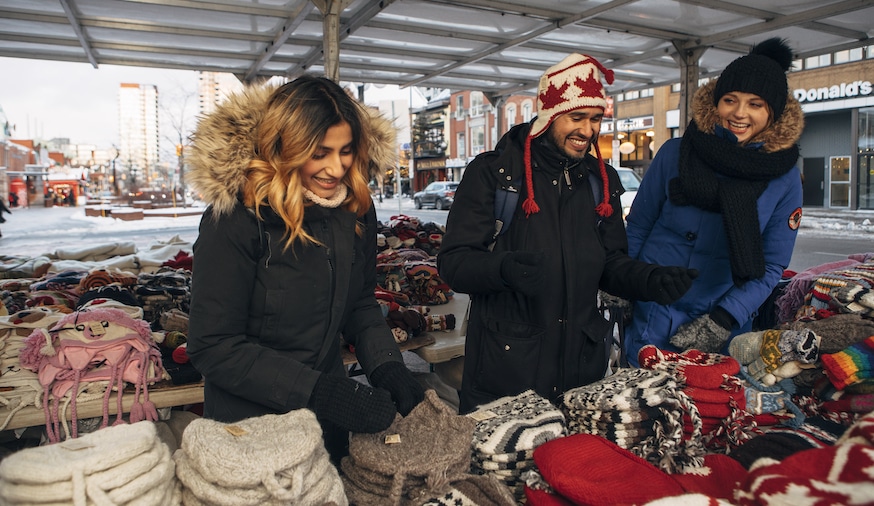
In a town where temperatures hover below freezing for much of the winter, woolen caps, mittens and mufflers sell quickly.
From Fancy to Funky
If you’re looking for something funkier than the National Arts Center head to Byward Market, a warren of streets chockablock with cafés, bars, and craft ateliers. On his first foreign trip as president in 2009, Barack Obama came to Ottawa and visited the Market’s Le Moulin de Provence, where he bought a shortbread cookie shaped like a maple leaf. The “Obama Cookie” remains a bestseller today.
It is here you’ll find Chateau Lafayette and the Heart and Crown Pub in the Irish Village. At Patrick McGahern Books, an Ottawa favorite for over 50 years, book lovers delight in a large collection of rare books and maps, many of them on Arctic Canada. If fashion is your thing, Frou Frou by Pat makes for a fun stop near the Market on York St. Should your tastes run to Inuit or First Nations art, check out Snow Goose at 88 Sparks, the pedestrian amble downtown.
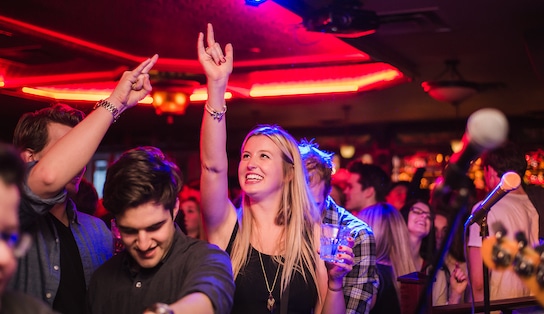
Heart and Crown dancing crowd
Take Me To The River
Perhaps the best views of Ottawa are from the water. Beside the dowager Chateau Laurier, a 1912 hotel named after an early Canadian prime minister, there are steps down to the river. Before heading down, however, pop into Zoe’s, a bar named for Laurier’s wife, and try a whiskey-based Statesman cocktail. Once fortified, you’ll find Paul’s Boat Line below at the dock. Cruising this stretch of the river is an easy way to enjoy major sights minus the crowds. There’s a statue of 17th century explorer Samuel de Champlain gazing out on the river he explored 400 years ago. Unfortunately, he’s holding his astrolabe upside down.
Next come the spiked towers of the National Gallery and on the opposite bank the Museum of Canadian History. It is a curvy structure that echoes the shapes of Canadian canoes with a grand entrance hall full of totem poles. Further on the river is the pyramid-shaped American Embassy followed by the Victorian Parliament Buildings.
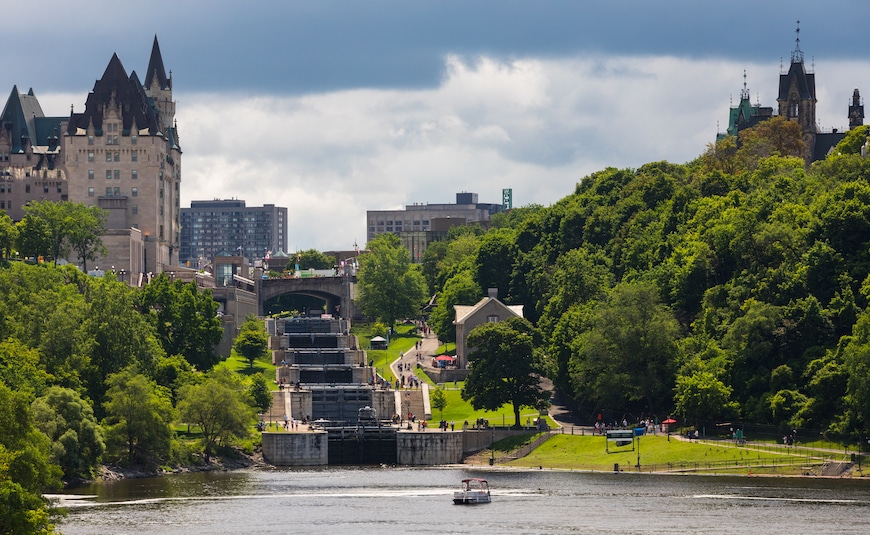
The Rideau Canal empties into the Ottawa River through a series of locks that separate the Canadian Parliament Building from the Chateau Laurier. Pleasure craft cruise the river throughout the summer.
Parliament’s high point, the Peace Tower, with its daily changing of flags, immense clock, frequent bells and requisite gargoyles, was built in 1919 to commemorate Canadian soldiers killed in the Great War.
After passing the largest newspaper factory in the world, passengers disembark beside the Bytown Museum, a 1827 structure used to store gunpowder and rum, imported by the British for the benefit of workers digging a canal linking Ottawa with Lake Ontario. After the canal’s completion, bloody fights between French and Irish lumberjacks battling for jobs in the timber industry made the place known as “Brawling Bytown.” There was no police force. To quote a young tour guide, “a hundred and fifty years ago, this place was nuts.”
The Evolution of Washington of the North
After Bytown became Ottawa the small, violent town faded away. Built high on a hill overlooking the river, the august Parliament district almost seemed worthy of the city’s new moniker, Washington of the North.
Although Victorian mores prevailed, Ottawa retained its quirks. During his 21 years in office, bachelor Prime Minister William Lyon Mackenzie King hosted seances to chat with his dead Mum, FDR, and his dog, Pat. Historic Laurier House, the residence that housed Prime Minister Wilfrid Laurier before opening its doors to Mackenzie King, is well worth a visit, if only because it sits across the street from Working Title, a cafe praised for its vegetarian dishes, boeuf bourguignon and in-house baked goods.
In 1940, the town once dismissed as “Brawling Bytown” became a sanctuary for Dutch royalty in exile. Dutch Princess Margriet was born in Ottawa. After the war ended, her mother, Queen Juliana, affectionately sent the 100,000 tulip bulbs in gratitude. More followed. Today, the city celebrates the arrival of Spring and its close relationship with the Netherlands each May with the Canadian Tulip Festival.
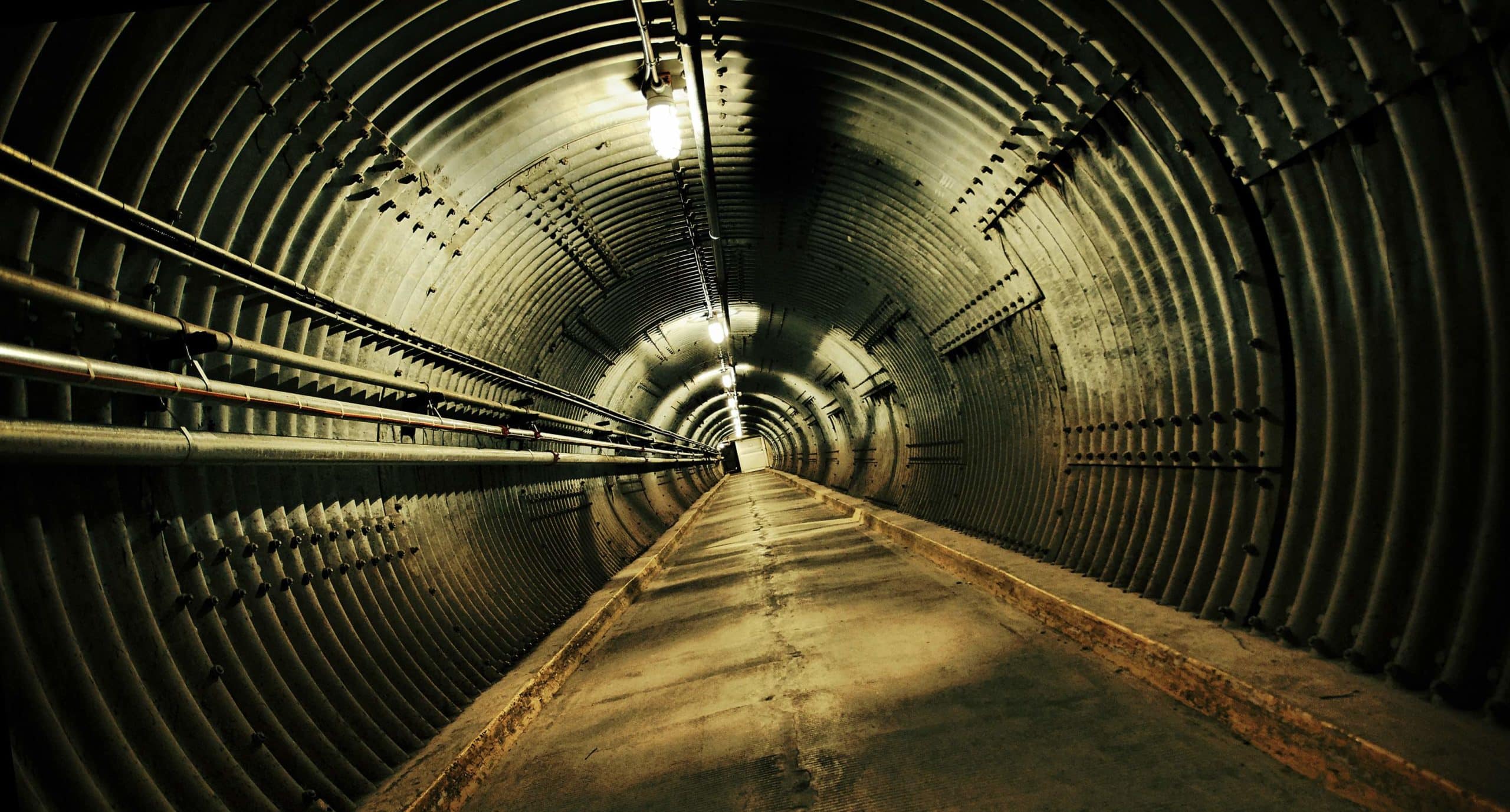
No need to duck and cover inside the Diefenbunker blast tunnel. Engineered to deflect shock waves from a nuclear blast, the tunnel is unnervingly asymmetrical.
Cool Times, Scary Imaginings
Ottawa first became cool–as opposed to merely freezing–when the Justice Minister and soon-to-be Prime Minister Pierre Trudeau, drove his Mercedes-Benz 300SL into town and straight into the hearts of the 60s generation. Then a bachelor, Pierre dated Barbra Streisand and welcomed protestors John and Yoko to Ottawa. But it’s John Diefenbaker, an earlier Prime Minister from Saskatchewan, whose name graces Ottawa’s most intriguing attraction.
Just outside town, in the village of Carp, you’ll find the Diefenbunker, an Emergency Government Headquarters built in 1961 to shelter government leaders in the event of nuclear attack. It lives on as a nifty Cold War Museum where you can see an old broadcasting studio and a vault built for Canada’s gold reserves.
Described as ” a brutish building with some neat features,” the bunker’s staff of 120 maintained everything until 1994. Now privatized, the bunker is more popular than ever, offering educational tours, party venues, an Escape Room, and a Spy School for kids.
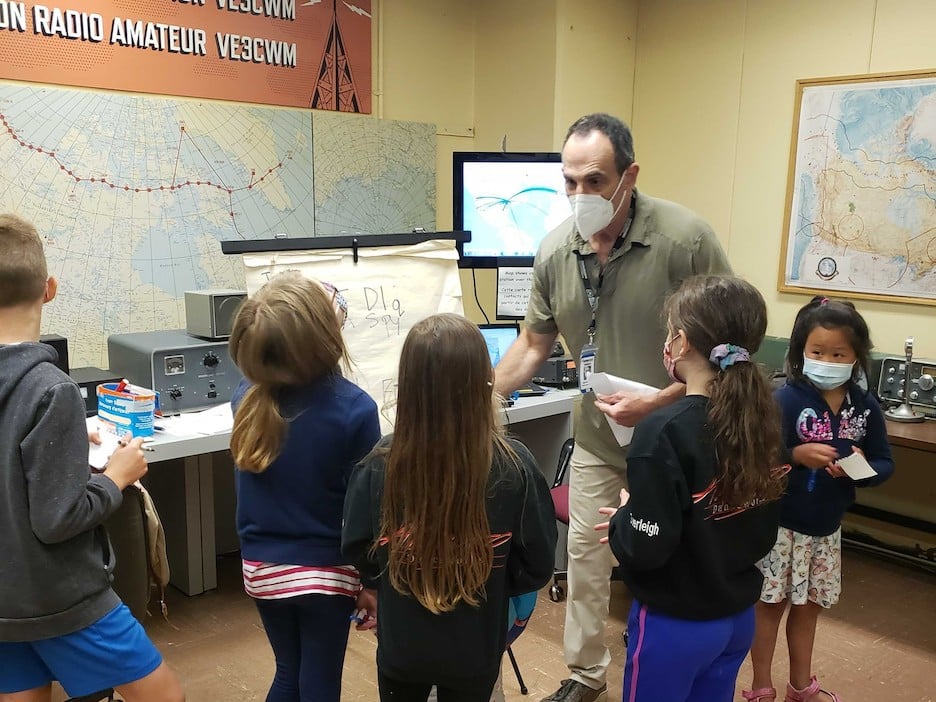
The Diefenbunker’s Spy School for Kids attracts a wide range of youthful operatives. There are no courses in interrogation or martial arts, but nobody seems to mind as long as cookies and milk are served at the end.
Cold War Jitters
You must take the one-hour tour of the Diefenbunker. Start by walking through a blast tunnel designed to deflect nuclear shock waves, then visit two lead-lined showers next to a Geiger counter used to detect post-shower radiation levels. A message center features giant computers and reel-to-reel tape recorders. Should Soviet saboteurs breach the other perimeter, exploding bolts would blast open two escape hatches and a ladder would appear. It’s easy to see where Ian Fleming got his inspiration for James Bond. That none of this was used doesn’t make the tour any less intriguing or the re-emergence into fresh air and a glittering sunset any less delightful.![]()
East-West News Service contributor Nancy Wigston lives in Toronto. In her recent stories she has explored Northern Argentina, traveled through Yorkshire and traced mystery writer Agatha Christie’s travels through the pages of her books.

